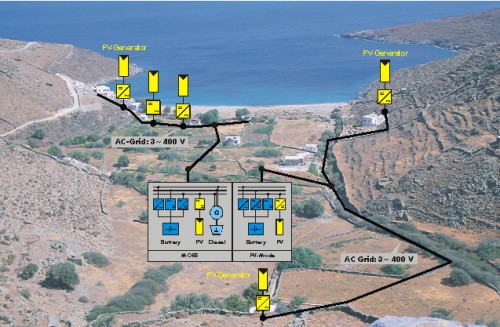Pilot Microgrids
F2. Kythnos Microgrid
Back

Figure 6.7 Kythnos Microgrid
The system in Gaidouromantra, Kythnos is a 1-phase Microgrid composed of the overhead power lines and a communication cable running in parallel. It is electrifying 12 houses in a small valley in Kythnos, an island in the cluster of Cyclades situated in the middle of the Aegean Sea. The grid and safety specifications for the house connections respect the technical solutions of the Public Power Corporation, which is the local electricity utility. The reason for such a decision was taken on grounds that potentially the Microgrid may be connected with the rest of the island grid. The power in each user's house is limited by a 6 Amp fuse. The settlement is situated about 4 kilometres away from the closest pole of the medium voltage line of the island. A system house of 20 m2 surface area was built in the middle of the settlement in order to house the battery inverters, the battery banks, the diesel genset and its tank, the computer equipment for monitoring and the communication hardware.
The grid electrifying the users is powered by 3 Sunny-island battery inverters connected in parallel to form one strong single-phase in a master slave configuration, allowing the use of more than one battery inverter only when more power is demanded by the consumers. Each battery inverter has a maximum power output of 3.6kW. The battery inverters in the Kythnos system have the capability to operate in both isochronous or droop mode. The operation in frequency droop mode gives the possibility to pass information on to switching load controllers in case the battery state of charge is low and also to limit the power output of the PV inverters when the battery bank is full.
The users' system is composed of 10kWp of Photovoltaics divided in smaller sub-systems and a battery bank of nominal capacity 53kWh and a diesel Genset with a nominal output of 5kVA. A second system with about 2 kWp mounted on the roof of the system house is connected to a Sunny-island inverter and a 32kWh battery bank. This second system provides the power for the monitoring and communication needs of the systems. The PV modules are integrated as canopies to various houses of the settlements. The installation of the grid and the systems was performed in the framework of two European projects (PV-MODE, JOR3-CT98-0244 and MORE, JOR3CT98-0215).
This network will be used to test centralized and decentralized control strategies in islanded mode. This is a major challenge for Microgrids. It will be also used to test communication protocols. In order to achieve these functionalities it is required to enhance the functionalities of the battery inverters (replace). It would be very beneficial for the system to integrate an AC wind turbine in the range of 2 to 3 kW in order to strengthen the power production of the system, minimize the use of diesel fuel and diversify the resources. A new monitoring system will be installed to give the opportunity to remotely connect via cellular phone to the system house and check the state of the operation and be able to up to transfer data and files.
In the new control strategies, it is suggested to keep the load management concept with the E-connect load controllers connected to the point of power input to each house and in addition to distinguish the flexible operation house appliances which will be equipped with a device that will disconnect them prior to reaching the point of disconnection of the whole house. Moreover, the intelligent load switch developed by ANCO and ICCS/NTUA will be field tested.